A few of Taiwan’s more remarkable sights are hidden in plain sight, but of all the readily-accessible wonders I’ve visited in the last few years, the Wormhole (蚯蚓坑) in New Taipei City’s Yongding District (永定) is probably the most startling.
Known mostly to locals up until a few years ago, the Wormhole today draws a steady stream of visitors year-round, but especially on hot summer weekends when it might be best to avoid the place unless you like company.
SLOT CANYONS
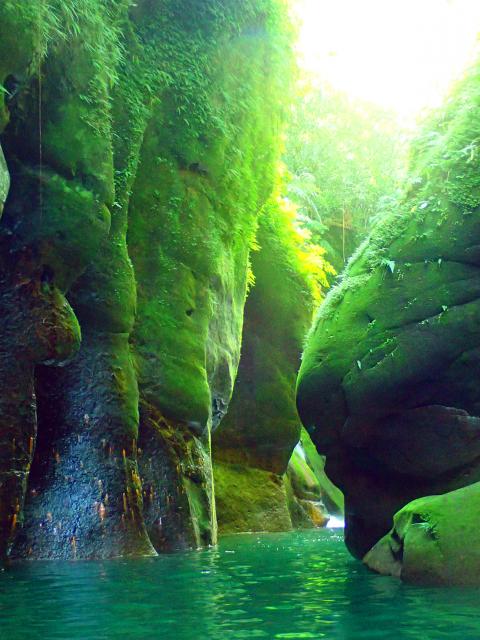
Photo: Richard Saunders
The Wormhole is a tiny slot canyon, a form of geological curiosity that’s surprisingly common in Taiwan. There are several other examples in the Taipei area. An outstandingly narrow and impressive one on a tributary of the Keelung River near New Taipei City’s Pingxi District (平溪) remains little-known, which is probably for the best, since it can only be reached by a strenuous river trace, and is potentially very dangerous, considering the area’s propensity for flash floods.
Safer and much easier to visit is the very small but atmospheric Chauyin Cave (潮音洞) on the slopes of Guanyin Mountain (觀音山) across the river from New Taipei City’s Tamsui District (淡水), and the gorge below the lovely Budong Waterfall (不動瀑布), just a short bus ride from the hot springs in Taipei’s Xinbeitou in Beitou District (北投). The Wormhole, however, is in a class of its own.
The slot canyon is just a couple of minutes from County Road 106, right on the popular bus route 795 between Muzha and Pingxi districts. Get off at Huangdidian (皇帝殿站) bus stop. Walk along the road away from Taipei for 200 meters, through the little village of Yongding, and take the road on the left, downhill to a bridge across the Yongding Creek (永定溪). Immediately before the bridge take a short path on the right, down through the trees to the edge of the little gorge just upstream from the Wormhole.
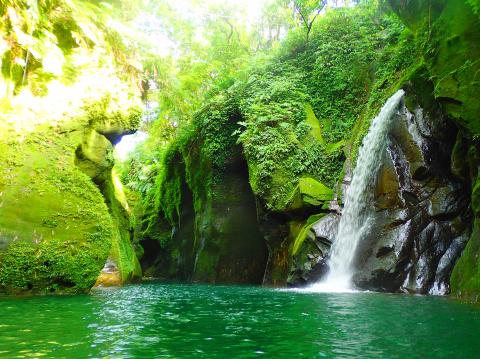
Photo: Richard Saunders
Anywhere else this fine little glen would be the main attraction, and it’s a great place to explore. It’s also a safer place than the Wormhole for less experienced swimmers, as the water isn’t as deep, and there are plenty of rocks to hold onto. Now is the time (before getting into the water) to check the condition of the stream. If it looks especially fast-flowing or high, don’t go any further to avoid any problems once you swim into the Wormhole.
Assuming the stream is fairly low, climb carefully down the slippery rockface above the water’s edge using the fixed rope, and cross the stream to the rocks on the other side. Follow the far bank down a few meters, then either re-cross the stream to the near bank and another patch of rocks at the eastern entrance to the Wormhole, or get straight into the water and swim under the bridge and into it.
EASY SAILING
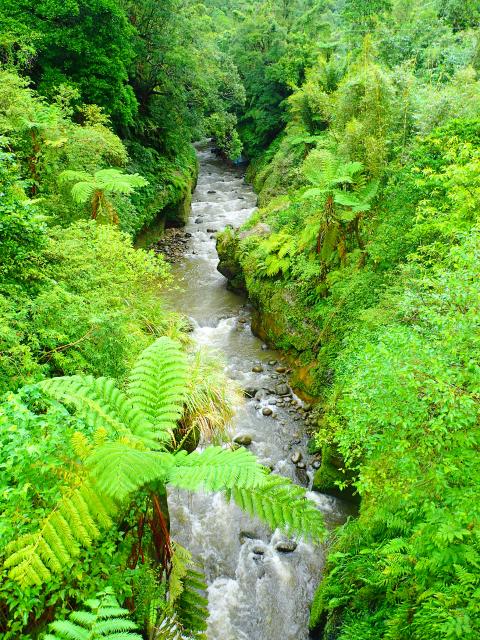
Photo: Richard Saunders
The Wormhole is a small but very beautiful slot canyon about 150 meters long, where the waters of the stream run deep and (usually) slowly. The walls, weirdly eroded into a sequence of smooth curves by countless summer floods, rise sheer above the emerald-green water, and are covered in a film of algae and fine moss.
About halfway through, a flat platform of rock just above the water level is a welcome place for a quick rest, and another 50 meters downstream, at the western end of the canyon, a tributary plunges over its side into the main stream via a rather beautiful waterfall.
Just after the waterfall the gorge abruptly ends, swimmers can once more touch the riverbed and a high bridge spans the gorge. Wade downstream a bit further and (apparently) it’s possible to climb out of the gorge and back to the road, avoiding the swim back upstream. But don’t count on this, and be sure to allow enough energy to swim back (against the current) to the beginning.
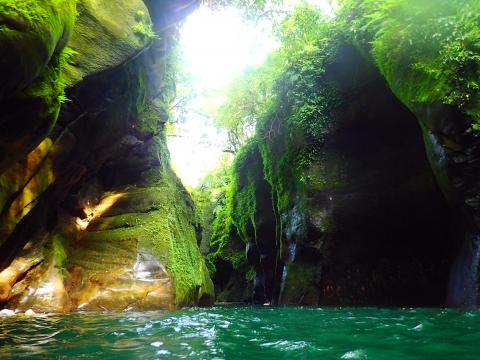
Photo: Richard Saunders
SAFETY FIRST
The Wormhole is an ideal spot to explore, especially on a hot summer day, but it’s potentially a dangerous one, and there have been accidents in the past. Once in the Wormhole, there’s only one spot to stop and rest until past the waterfall at its western end, and swimming back you’ll be swimming against the current, so be sure to bring some kind of flotation device (such as a life jacket or large inflatable ring) in case you need a rest. Swim with a few friends, and don’t even think of getting in unless you’re a confident swimmer and the river is low.
IF YOU GO
The Wormhole is next to County Road 106, in the village of Yongding, about midway between Shenkeng (深坑) and Pingxi (平溪), and is very easy to reach by public transport. Take the MRT to Muzha MRT station, leave by the only exit and walk down to the main road out front. Take bus 795 from the stop across the road to Huangdidian (皇帝殿站) bus stop, about thirty minutes. Buses run to a timetable, every 20-30 minutes at weekends.
Richard Saunders is a classical pianist and writer who has lived in Taiwan since 1993. He’s the founder of a local hiking group, Taipei Hikers, and is the author of six books about Taiwan, including Taiwan 101 and Taipei Escapes. Visit his Web site at www.taiwanoffthebeatentrack.com.
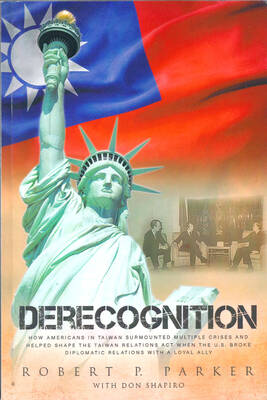
One of the biggest sore spots in Taiwan’s historical friendship with the US came in 1979 when US president Jimmy Carter broke off formal diplomatic relations with Taiwan’s Republic of China (ROC) government so that the US could establish relations with the People’s Republic of China (PRC). Taiwan’s derecognition came purely at China’s insistence, and the US took the deal. Retired American diplomat John Tkacik, who for almost decade surrounding that schism, from 1974 to 1982, worked in embassies in Taipei and Beijing and at the Taiwan Desk in Washington DC, recently argued in the Taipei Times that “President Carter’s derecognition

This year will go down in the history books. Taiwan faces enormous turmoil and uncertainty in the coming months. Which political parties are in a good position to handle big changes? All of the main parties are beset with challenges. Taking stock, this column examined the Taiwan People’s Party (TPP) (“Huang Kuo-chang’s choking the life out of the TPP,” May 28, page 12), the Democratic Progressive Party (DPP) (“Challenges amid choppy waters for the DPP,” June 14, page 12) and the Chinese Nationalist Party (KMT) (“KMT struggles to seize opportunities as ‘interesting times’ loom,” June 20, page 11). Times like these can

Dr. Y. Tony Yang, Associate Dean of Health Policy and Population Science at George Washington University, argued last week in a piece for the Taipei Times about former president Ma Ying-jeou (馬英九) leading a student delegation to the People’s Republic of China (PRC) that, “The real question is not whether Ma’s visit helps or hurts Taiwan — it is why Taiwan lacks a sophisticated, multi-track approach to one of the most complex geopolitical relationships in the world” (“Ma’s Visit, DPP’s Blind Spot,” June 18, page 8). Yang contends that the Democratic Progressive Party (DPP) has a blind spot: “By treating any

You can tell a lot about a generation from the contents of their cool box: nowadays the barbecue ice bucket is likely to be filled with hard seltzers, non-alcoholic beers and fluorescent BuzzBallz — a particular favorite among Gen Z. Two decades ago, it was WKD, Bacardi Breezers and the odd Smirnoff Ice bobbing in a puddle of melted ice. And while nostalgia may have brought back some alcopops, the new wave of ready-to-drink (RTD) options look and taste noticeably different. It is not just the drinks that have changed, but drinking habits too, driven in part by more health-conscious consumers and